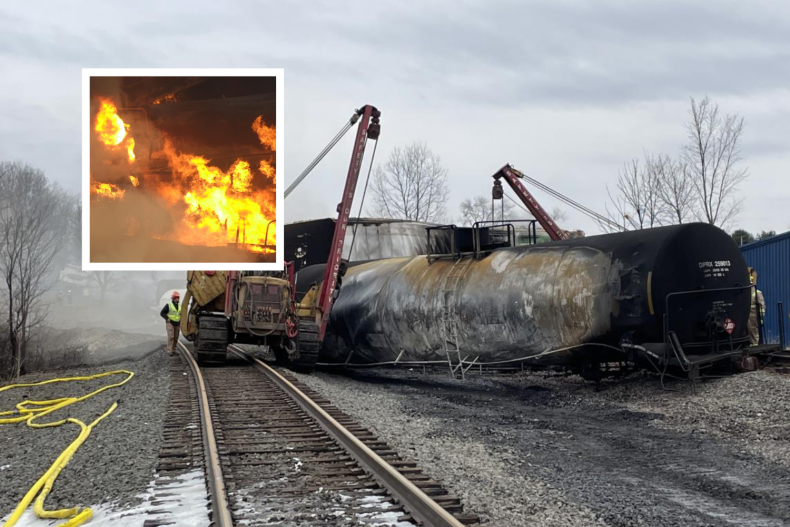Ohio Train Derailment: Investigation Into Lingering Toxic Chemicals In Buildings

Table of Contents
Testing and Detection of Lingering Chemicals in Buildings
Detecting and identifying specific chemicals in building materials following the Ohio train derailment presents significant analytical challenges. The low concentrations of potentially hazardous substances dispersed over a wide area make precise detection difficult. Several testing methods are employed to assess the extent of contamination. Air quality testing involves measuring the concentration of volatile organic compounds (VOCs) in the air within and around affected buildings. Material sampling, on the other hand, requires collecting samples of dust, paint, flooring, and other building materials for laboratory analysis. The precise identification of the chemicals and quantification of their levels are crucial, yet determining the long-term health effects from low-level exposure remains a complex undertaking.
- Air quality testing protocols and limitations: Current protocols focus on identifying specific VOCs linked to the derailment, but limitations exist in detecting chemicals that have degraded or reacted with other substances.
- Types of samples collected: Samples are analyzed to identify the presence and concentration of various chemicals, including vinyl chloride, butyl acrylate, and other byproducts of the initial chemical reaction.
- Laboratory analysis techniques and turnaround times: Sophisticated techniques, such as gas chromatography-mass spectrometry (GC-MS), are used for precise chemical identification, but analysis can be time-consuming.
Potential Health Impacts of Lingering Chemical Exposure
Exposure to the chemicals released in the Ohio train derailment, including vinyl chloride and butyl acrylate, carries significant potential health risks. Vinyl chloride, a known carcinogen, is associated with an increased risk of liver cancer, brain cancer, and other serious illnesses. Butyl acrylate, a respiratory irritant, can cause short-term respiratory problems like coughing, wheezing, and shortness of breath, and prolonged exposure may lead to more severe effects. The symptoms of exposure can vary depending on the chemical, the level of exposure, and individual sensitivities. Early detection is crucial for effective intervention and mitigating long-term health consequences. Vulnerable populations, including children, the elderly, and individuals with pre-existing respiratory or cardiovascular conditions, are particularly at risk.
- Specific health problems linked to vinyl chloride exposure: Liver angiosarcoma, a rare and aggressive form of liver cancer, is a particularly serious concern.
- Potential respiratory issues from butyl acrylate inhalation: Irritation of the eyes, nose, and throat is common, alongside more severe respiratory problems in individuals with pre-existing conditions.
- Long-term effects such as cancer risk: The long-term health impacts of low-level, chronic exposure to these chemicals are still being investigated and are a major concern for researchers and public health officials.
Cleanup and Remediation Efforts in Affected Buildings
Cleaning and remediating buildings contaminated with toxic chemicals from the Ohio train derailment is a complex and multifaceted undertaking. It requires a careful assessment of the extent of contamination, selection of appropriate remediation techniques, and rigorous monitoring to ensure the effectiveness of the cleanup efforts. Remediation techniques may include decontamination, which involves removing or neutralizing contaminants on surfaces, or more drastic measures like demolition and material replacement. Regulatory oversight is crucial in ensuring the safety and effectiveness of these operations. Various agencies, including the Environmental Protection Agency (EPA), are involved in overseeing the cleanup, establishing guidelines, and ensuring compliance.
- Cost and time involved in building remediation: The cost of remediation can be substantial, and the process can take months or even years to complete, depending on the extent of contamination.
- Environmental protection measures during cleanup: Stringent safety measures must be employed to protect workers and the environment during remediation efforts.
- Long-term monitoring strategies: Ongoing monitoring is critical to ensure that the cleanup has been effective and to detect any potential resurgence of contamination.
Legal and Regulatory Responses to the Ohio Train Derailment
The Ohio train derailment has significant legal and regulatory ramifications. Investigations are underway to determine the cause of the derailment and assign responsibility for the release of toxic chemicals. Federal and state agencies are playing key roles in overseeing the cleanup, investigating the causes of the incident, and holding responsible parties accountable. Lawsuits have been filed against the railroad company and other potentially responsible parties, and the legal proceedings are likely to be protracted.
- Key legislation and regulations applicable to the situation: Federal regulations regarding hazardous materials transportation and environmental protection are central to the legal proceedings.
- Potential fines and penalties for negligence: Significant penalties could be levied against responsible parties if negligence is proven.
- Ongoing legal proceedings and their potential outcomes: The legal battles surrounding the derailment will likely shape future regulations and practices in hazardous materials transportation.
Continued Vigilance: The Ongoing Investigation of Ohio Train Derailment Lingering Toxic Chemicals
The investigation into the lingering toxic chemicals from the Ohio train derailment is ongoing, and its implications for public health and the environment are far-reaching. Ongoing testing, thorough remediation efforts, and careful health monitoring are crucial for protecting the community. Transparency and accountability from responsible parties are essential to ensuring that effective measures are implemented to address the long-term consequences of this catastrophic event. If you suspect chemical exposure in your building, seek professional advice immediately. Stay informed about the latest developments by following reputable news sources and official government updates on the Ohio train derailment lingering toxic chemicals situation. Your health and the health of your community depend on it.

Featured Posts
-
 Section 230 And Banned Chemicals On E Bay A Judges Ruling
Apr 27, 2025
Section 230 And Banned Chemicals On E Bay A Judges Ruling
Apr 27, 2025 -
 Napoleon Ceo Emphasis On Buying Canadian Goods
Apr 27, 2025
Napoleon Ceo Emphasis On Buying Canadian Goods
Apr 27, 2025 -
 Pfc To Announce Fourth Dividend For Fy 25 On March 12 2025
Apr 27, 2025
Pfc To Announce Fourth Dividend For Fy 25 On March 12 2025
Apr 27, 2025 -
 Justin Herbert Chargers 2025 Brazil Season Opener
Apr 27, 2025
Justin Herbert Chargers 2025 Brazil Season Opener
Apr 27, 2025 -
 New Pushback From Car Dealers Against Electric Vehicle Regulations
Apr 27, 2025
New Pushback From Car Dealers Against Electric Vehicle Regulations
Apr 27, 2025
Latest Posts
-
 Trade Wars Hurt Alberta Dows Megaproject Suffers Setback
Apr 28, 2025
Trade Wars Hurt Alberta Dows Megaproject Suffers Setback
Apr 28, 2025 -
 9 Billion Dow Project In Alberta Delayed By Trade Tariffs
Apr 28, 2025
9 Billion Dow Project In Alberta Delayed By Trade Tariffs
Apr 28, 2025 -
 Alberta Faces Economic Blow From Tariffs Dow Megaproject Delayed
Apr 28, 2025
Alberta Faces Economic Blow From Tariffs Dow Megaproject Delayed
Apr 28, 2025 -
 Alberta Economy Hit Dow Project Delay Amidst Tariff Fallout
Apr 28, 2025
Alberta Economy Hit Dow Project Delay Amidst Tariff Fallout
Apr 28, 2025 -
 Dows 9 B Alberta Project Delayed Collateral Damage From Tariffs
Apr 28, 2025
Dows 9 B Alberta Project Delayed Collateral Damage From Tariffs
Apr 28, 2025
